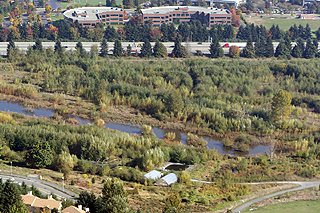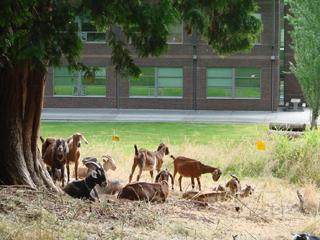|
Subscribe / Renew |
|
|
Contact Us |
|
| ► Subscribe to our Free Weekly Newsletter | |
| home | Welcome, sign in or click here to subscribe. | login |
Construction
| |
 |
September 20, 2007
Cascadia college building will be green inside and out
Otak

Rogers
|
Cascadia Community College in Bothell is one of the first colleges to commit to the American College & University Presidents Climate Commitment to neutrality.
This journey began with the college’s wholesale adoption of carbon-neutral strategies, from composting food scraps in worm bins and using green cleaning products to using a hybrid fleet car and subsidizing bus passes. The next logical step, however, was to design a green building that met the college’s goals for stewardship of the land.
The $32.6 million Center for Global Learning and the Arts will do just that. Scheduled for occupancy in the fall of 2009, the building will be soon certified as the first LEED green building on campus. Its design and construction has relied on one dozen professionals from all sectors of the college, as well as at least one dozen members on the design team alone. This collaboration will reap immediate and long-term benefits.
“The global learning center provides an opportunity to keep improving on the college’s existing environmental goals,” says Dee Sliney, director of capital projects and auxiliary services at CCC. “After certifying to LEED for New Construction, we hope to also certify our existing buildings under LEED for Existing Buildings, which helps monitor and ensure the ongoing operations and maintenance of a green building.”
Defining goals
LEED, or Leadership in Energy and Environmental Design, is a rating program that provides a yardstick of sorts for measuring sustainable qualities of a green building.
The state of Washington has mandated that all capital projects achieve a LEED silver designation, the second level of a four-tier system. With the collaboration of all involved parties at CCC, though, both Sliney and architect Margaret Sprug believe this building might even achieve LEED gold status.
During the initial stages of design, the project’s green consultant, O’Brien & Co., brought the entire team together to brainstorm ideas for the environmental goals of the building.
“The green building process works best as a team,” says Elizabeth Powers, a principal with O’Brien & Co.
Otak principal and site civil engineer Nico Vanderhorst agrees. “In a multi-building environment such as a college, healthy site functions are essential to the ongoing site maintenance for stormwater runoff, irrigation and landscaping. It was helpful for us to be in the same room with the building designers discussing how the runoff from the roof and hard surfaces impacts water on the landscape, for example.”
Margaret Sprug, an associate at the Miller/Hull Partnership, says the project has seen a lot of give and take as the team seeks to provide the most functional building with the least impact. “We hoped initially that we could install a geothermal heating and cooling system for the building. However, the better solution ultimately was to use the school’s existing central physical plant, which will save the college money but still provide heat to the building efficiently.”
Treating runoff

One of the biggest challenges posed by any building to a site is how it sheds rainwater: where it goes, how it’s channeled, how to treat it, and how to prevent it from entering the building at ground level.
Before any construction begins, a plan is created to ensure all development and construction follows stringent guidelines to prevent erosion and pollution during construction and beyond.
The Center for Global Learning and the Arts treats rainwater in several ways: through a 500-square-foot vegetated roof that captures water before it gets to the site, through a storage system that collects rainwater and reuses it to irrigate landscaping, and through the natural filtration processes in an adjacent wetland.
This 58-acre restored wetland, which serves the shared campuses of CCC and the University of Washington Bothell, will receive water directly from the new global learning center, which will release clean rooftop rainwater and groundwater directly into the wetlands.
This water will then flow into the recently restored North Creek and be transported to the Sammamish River, about 500 feet downstream. The runoff will infiltrate and recharge the wetland and any excess water will flow across the wetland vegetation before entering North Creek, thus protecting the existing stream channels from excessive erosion.
Runoff is also treated by a system of four treatment “trains” that provide water-quality treatment of runoff from all over campus, including roadways and parking lots. Each treatment “train” includes a mechanical oil-water separator to remove oils, a settling vault to remove sediment, and a biofiltration swale to provide final filtration. These systems are part of the overall plan for eliminating pollutants from the campus site, but another green method may garner more attention.
Clearing weeds
CCC has been pesticide-free since July 2006. As part of its LEED submission, the project will seek an innovation credit for an integrated pest-management strategy that, according to Powers, carries the green ideas of the building forward in healthy, long-term maintenance of the grounds.
To remove dozens of blackberries choking the site without using herbicides, the college hired 60 goats from Rent-A-Ruminant. This non-polluting, almost zero-emissions decision eliminated an invasive plant species in just a few days and it was so successful that the college will try a larger herd of goats from Healing Hooves to clear a more extensive, vegetated site on campus, adjacent to the Center for Global Learning and the Arts.
Planting the campus
Miller/Hull’s design for the global learning center focused on saving trees, and the school hired an arborist to identify healthy trees and their locations.
Unfortunately, one of the large heritage trees on the site could not be saved, but the college has found ways to ensure its survival in perpetuity. The school is collecting seeds to propagate into at least 50 saplings that will be planted around campus. In addition, wood from the tree itself will be used in various aspects of the new building.
With this building, the college is also planting the seeds for future development on campus, including a planned wetlands environmental center that will showcase the 58-acre wetlands itself.
Sliney hopes that this new wetlands facility will be a zero net energy building and achieve LEED platinum, the highest rating possible. For now, the college will continue to use its wetlands and worm bins as real-life examples for its environmental science courses to plant the seeds of change with its students.
Robin Rogers is the sustainability advisor for Otak, a 500-person architecture, engineering, and planning firm that has been consulting on the Cascadia Community College and University of Washington Bothell campus since the early 1990s.
Other Stories:
- Case for operable windows isn’t open and shut
- Owners, designers can harness the Web too
- ‘I wish I could go to a school just like this’
- Light ‘chimneys’ cool off Tacoma school
- Performing arts spaces gain sophistication
- Lynnwood a proving ground for green schools
- Spokane takes a chance on GC/CM
- Seattle gets creative to expand bidding pool
- Public school projects fall out of favor with bidders
- Tomorrow’s schools will be greener, freer



